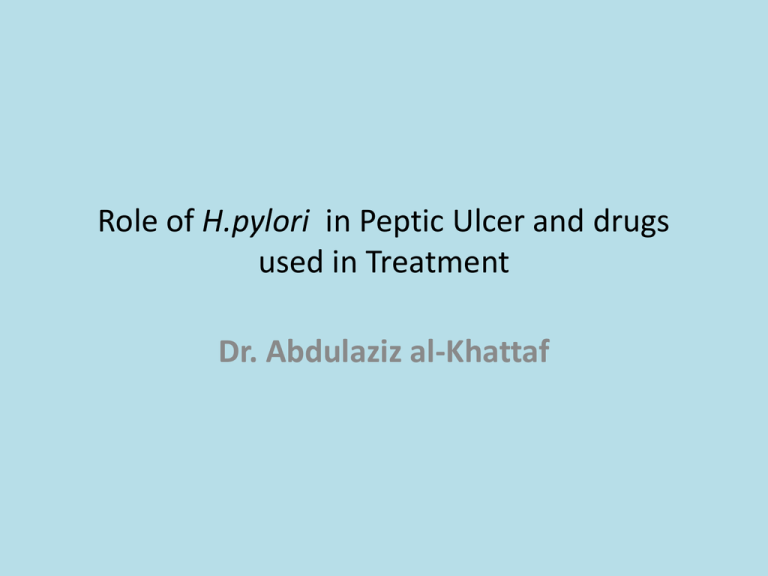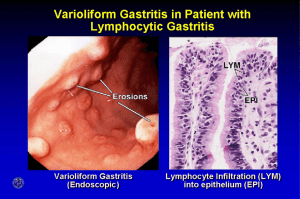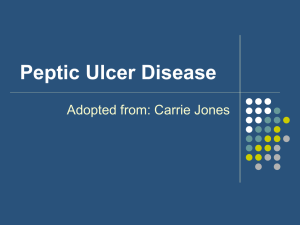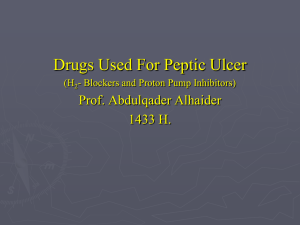L1- Role of H.pylori..
advertisement

Role of H.pylori in Peptic Ulcer and drugs used in Treatment Dr. Abdulaziz al-Khattaf Peptic ulcer • Peptic ulcer disease (PUD): • Is an ulcer define as mucosal erosions(≥ 0.5cm) associated with the over usage of NSAIDs. • Peptic ulcer is created in an acidic area (very painful). • More Peptic ulcers are arise in duodenum than stomach. • 4% of stomach ulcer can turn to be malignant tumor. • Duodenal ulcers are generally benign. • Multiple biopsies are needed to exclude cancer. Peptic ulcer images Signs and symptoms • Abdominal pain, epigastric with severity relating to mealtime (3 hours after meal with gastric ulcer). • Bloating and abdominal fullness. • Nausea and vomiting. • Loss of appetite and weight loss. • Haematemesis (vomiting of blood) due to gastric or esophagus damage. • Melena (foul-smelling dark brown faeces due to oxidized hemoglobin iron. • Rarely, Gastric or duodenal perforation leading to acute peritonitis(extremely painful-require urgent surgery. Helicobacter pylori • 1983 in Perth (Australia),Warren and Marshal. • Discovery revolutionised the treatment of duodenal and gastric ulcers. • Earned them the Nobel Prize for Medicine in 2005. • Nearly 20 species of Helicobacter are now recognised. • H. pylori are found in the human stomach. Molecular studies suggest transmission from an animal source. Helicobacter pylori • Helicobacter pylori (formerly known as Campylobacter.pylori or C.pyloridis) is found closely associated with gastric mucosa and causes chronic active gastritis, gastric and duodenal ulcer (Peptic ulcer) and could develop adenocarcinoma and gastric mucosa-associated lymphoid tissue (MALT) lymphoma. • H.pylori plays a role in gastric and duodenal ulceration and probably also gastric cancer. Over 80% of individuals infected with the bacterium are asymptomatic. • More than 50% of the world's population harbour H. pylori in their upper gastrointestinal tract. Infection is more prevalent in developing countries. • The route of transmission is unknown, although it is known individuals typically become infected in childhood. Description • Gram-negative spiral bacillus • Fastidious in terms of growth requirements • :strictly micro-aerophilic • :require C02 for growth/ charcoal • :on chocolate agar medium • Morphology and staining small, Gramnegative, spiral rods, motile by polar flagella. Laboratory characteristics • Culture: on blood or chocolate agar in a moist microaerophilic atmosphere. For isolation from clinical specimens, use campylobacter selective medium. Small colonies grow after 57 days at 37˚C. • Hallmark of the species is production of urease enzyme • -urease breaks urea down to C02+NH3 • -amonia is a strong base • -process helps H. pylori survive strongly acidic stomach conditions. • Very fragile (a point of importance when referring samples to the lab) Laboratory characteristics • Biochemical reactions: catalase-positive; oxidase-positive; strongly urease-positive. • Typing: a variety of nucleic acid methods have been developed, but there is no agreed typing scheme. • Serology: IgG and IgM to Cytotoxic Associated Gene A (CagA)and (VacA) for virulence strains. Diagnosis • • • • • • • Checking for dyspeptic patients for H pylori. Non-invasive methods: Serology (Blood antibody) tests (IgG, IgM or IgA). poor accuracy Stool antigen test. Carbon urea breath test (C14 or C13 ). a urea solution labelled with C14 isotope is given to pt. The C02 subsequently exhaled by the pt contains the C14 isotope and this is measured. A high reading indicates presence of H. Pylori. • Polymerase chain reaction (PCR) Invasive methods • Invasive methods (most reliable): • Histological examination of biopsy specimens of gastric/duodenal mucosa take at endoscopy. 1. CLO-test ® : based again on urease-production by the organism->NH3 production->rise in pH=>change in the colour indicator of the kit High sensitivity and specificity-Prompt result. • Endoscopy followed by culturing the bacteria. used for antibiotic resistance testing, as sensitive as the histology. Requires selective agars and incubation periods. Genome • H pylori consist of large diversity of strains with 1.550 genes. • Study of H pylori is centered on trying to understand the pathogenesis of genome database. • H pylori contain 40kb-long Cag pathogenicity island (PAI) with over 40 pathogenetic genes. • The cagA gene codes for the major H pylori virulence proteins. • Asymptomatic patients carry H pylori strains lacking the Cag pathogenesity island (PAI). Pathophysiology • To colonize the stomach, H pylori must survive acidity. • Using flagella, H pylori moves through stomach lumen and drill into the mucoid lining of stomach. • Produces adhesions that binds to the epithelial cells. • Produces large amounts of urease enzyme that break down urea into co2 +ammonia. • This in-turn neutalizes gastric acid. • Ammonia is toxic to epithelial cells along with proteases, vacA protein and phospholipases produced by H pylori and could damage epithelial cells. Pathophysiology- cont • Colonization of stomach or duodenum results in chronic gastritis (inflammation of stomach lining). • Inflammation stimulate more production of gastric acid. • This leads to gastric and duodenal ulcers, atrophy and later cancer. • CagA protein was found to contribute to peptic ulcer. • Neutrophil-Activating Protein (NAP) recruits neutrophils to gastric mucosa causing inflammation. • Free radical production in the gastric lining due to H pylori , increases host cell mutation. • H pylori induces the production of TNF-α and Interleukin 8 that leads to host cells mutation. Prevention • • • • • Eradication of infection will improve symptoms: Such as (dyspepsia, gastritis, peptic ulcer and cancer). Vaccination: Promising results with studying adjuvant, antigens. Determining route of immunization (oral or intramuscular). • Dietary methods: (eating broccoli, cabbage, honey, and drinking green tea). • Proper sanitation and clean sources of drinking water). Epidemiology • • • • • Around 50% of world’s population harbor H pylori. Third world has more rate of infection. Infections are usually acquired at childhood. Poor sanitary conditions contribute to high rates. In USA high prevalence among African-American and Hispanic population-Due to socioeconomic status. • Higher hygiene standards and widespread use of antibiotics behind lower rate of infection in the west. • Overall frequency of H pylori infection is declining. • Prevalence varies greatly among countries and population groups. Transmission • Contagious with an unknown route of transmission . • Person to person (oral to oral or fecal-oral) route. • Transmission occur mainly within families or community. • Fecal-oral route of infection occur by ingestion contaminated food or water due poor hygiene. • Using same spoons, forks and tooth brushes and kissing children mouth to mouth increases oral-oral route of infection. • Gastric antrum is the most favoured site. • Present in the mucus that overlies the mucosa. Gastric-biopsy specimen showing Helicobacter pylori adhering to gastric epithelium and underlying inflammation The outcome of infection by H. pylori reflects an interaction between Strain virulence Environmental factors Host genotype Antibiotic sensitivity • In vitro H.pylori is sensitive to amoxycillin, tetracycline, metronidazole, macrolides (clarithromycin). • However, in vivo their efficacy is often poor due to the low pH of the stomach, their failure to penetrate the gastric mucus and the low concentration of antibiotic obtained in the mucosa of the stomach. • Recently , Metronidazole in developing countries is becoming resistance (80-90%). • First line therapy • PPI (RBC) b.d. + clarithromycin 500mg b.d. • + • amoxicillin 1000mg b.d. or metrodiazole 500md BD minimum of 7 days • In case of failure • Second line therapy • PPI b.d. + bismuth subsalicylate/subcitrate 120mg QDS + metronidazole 500mg t.d.s. + tetracycline 500mg q.d.s. • for a minimum of 7 days • If bismuth is not available, PPI based triple therapies should be used • Subsequent failures should be handled on a case-case basis. Patients failing second-line therapy in primary care should be referred Triple therapies • One-week combination of Omeprazole, Clarithromycin and Tinidazole the rate of eradication was 95%-100%. • 10 days’ combination of Ranitidine Bismuth citrate, Amoxycillin and Clarithromycin with eradication rate of no more than 75%. • 10 days combination of Ranitidine Bismuth citrate, Clarithromycin and metronidazole with an eradication rate of 90%. • One-week combination of Omeprazole, Amoxycillin and metronidazole the rate of eradication was 96%-( very cost effective). Quadruple Therapies • 7days regimen of combination of Amoxycillin , metronidazole, Ranitidine Bismuth Citrate and proton pump inhibitor (Omeprazole) have shown to increase the eradication rate up to 98%. Unfortunately it was followed by side effects such as vaginal candidiasis in 10% of women and Pseudomembranous colitis in 11% of patients. Recommendations for treatment of H pylori infection (Maastricht III Consensus Report) 2007 • Due to Clarithromycin development of resistance, susceptibility testing is recommended pretreatment. • Further standardization is recommended for Metronidazole before susceptibility testing is done. • PPI-Clarithromycin-Amoxicillin or Metronidazole treatment remains the first choice treatment if clarithromycin resistance is less than 15-20%. • With less than 40% Metronidazole resistance prevalence PPI-Clarithromycin-metronidazole is used. • Bismuth-based quadruple theapies remain best second choice treatment if available. Reference book • Sherries Medical Microbiology, an Introduction to Infectious Diseases. Latest edition, Kenneth Ryan and C.George Ray. Publisher : McGraw Hill . Chapter 22: page 380-384.


![L1-Role of H[1].pylori in peptic ulcer and drugs used in treatment](http://s2.studylib.net/store/data/009899953_1-56989747ac9653ba71f85ce2e2b229f0-300x300.png)




